Subjects
Shows
Evaluate the quality and effectiveness of one’s own and others’ musical performances and creations by applying specific and appropriate criteria, [...]
Introduce and explore creating contrasting and complimentary shapes, and taking and supporting weight with a partner.
Introduce and explore creating movement that communicates a topic of personal significance.
Introduce the concept of dance analysis and the appropriate dance/movement vocabulary.
Introduce and be able to identify different accompaniment that could have an affect on the meaning of dances.
Introduce and explore the concept of using different lighting and costumes to contribute to the meaning of a dance.
Introduce manipulation of movement and the concepts related to movement selection.
Demonstrate appropriate audience behavior while watching live dance, including how to appropriately express their opinions during and after the performance.
Identify and demonstrate understanding of dance elements, space, time, and force when looking at a dance.
Explore individual components used in determining aesthetic criteria such as skills of performers, originality, visual and/or emotional impact, variety, and [...]
Introduce, research, and explore folk, social, or theatrical dance forms learned from resources in their own community, of different cultures, [...]
Introduce, research, and explore the role of dance in a culture or time period.
Introduce, research, and explore similarities and differences of other art disciplines.
Sing and play with expression and technical accuracy, an increasingly diverse repertoire of literature at developmentally-appropriate levels. Perform at least [...]
Exposure to the concepts of alignment, balance, initiation of movement, articulation of isolate body parts, weight shifts, elevation and landing, [...]
Explore and demonstrate basic dance steps and position from two different styles or traditions.
Introduce and explore the concepts of kinesthetic awareness, concentration, and focus in performing movement skills.
Introduce and explore the concept of memorizing and reproducing a movement sequence.
Draw evidence from informational texts to support analysis reflection, and research.
Compare and contrast the information gained from experiments, simulations, video, or multimedia sources with that gained from reading a text [...]
Write arguments focused on discipline-specific content.
Write routinely over extended time frames (time for reflection and revision) and shorter time frames (a single sitting or a [...]
Introduce claim(s) about a topic or issue, acknowledge and distinguish the claim(s) from alternate or opposing claims, and organize the [...]
Support claim(s) with logical reasoning and relevant, accurate data and evidence that demonstrate an understanding of the topic or text, [...]
Use words, phrases, and clauses to create cohesion and clarify the relationships among claim(s), counterclaims, reasons, and evidence.
Provide a concluding statement or section that follows from and supports the argument presented.
Write informative/explanatory texts, including the narration of historical events, scientific procedures/ experiments, or technical processes.
Introduce a topic clearly, previewing what is to follow; organize ideas, concepts, and information into broader categories as appropriate to [...]
Develop the topic with relevant, well-chosen facts, definitions, concrete details, quotations, or other information and examples.
Use appropriate and varied transitions to create cohesion and clarify the relationships among ideas and concepts.
Use precise language and domain-specific vocabulary to inform about or explain the topic.
Establish and maintain a formal style and objective tone.
Provide a concluding statement or section that follows from and supports the information or explanation presented.
Subjects
Shows
Evaluate the quality and effectiveness of one’s own and others’ musical performances and creations by applying specific and appropriate criteria, [...]
Introduce and explore creating contrasting and complimentary shapes, and taking and supporting weight with a partner.
Introduce and explore creating movement that communicates a topic of personal significance.
Introduce the concept of dance analysis and the appropriate dance/movement vocabulary.
Introduce and be able to identify different accompaniment that could have an affect on the meaning of dances.
Introduce and explore the concept of using different lighting and costumes to contribute to the meaning of a dance.
Introduce manipulation of movement and the concepts related to movement selection.
Demonstrate appropriate audience behavior while watching live dance, including how to appropriately express their opinions during and after the performance.
Identify and demonstrate understanding of dance elements, space, time, and force when looking at a dance.
Explore individual components used in determining aesthetic criteria such as skills of performers, originality, visual and/or emotional impact, variety, and [...]
Introduce, research, and explore folk, social, or theatrical dance forms learned from resources in their own community, of different cultures, [...]
Introduce, research, and explore the role of dance in a culture or time period.
Introduce, research, and explore similarities and differences of other art disciplines.
Sing and play with expression and technical accuracy, an increasingly diverse repertoire of literature at developmentally-appropriate levels. Perform at least [...]
Exposure to the concepts of alignment, balance, initiation of movement, articulation of isolate body parts, weight shifts, elevation and landing, [...]
Explore and demonstrate basic dance steps and position from two different styles or traditions.
Introduce and explore the concepts of kinesthetic awareness, concentration, and focus in performing movement skills.
Introduce and explore the concept of memorizing and reproducing a movement sequence.
Draw evidence from informational texts to support analysis reflection, and research.
Compare and contrast the information gained from experiments, simulations, video, or multimedia sources with that gained from reading a text [...]
Write arguments focused on discipline-specific content.
Write routinely over extended time frames (time for reflection and revision) and shorter time frames (a single sitting or a [...]
Introduce claim(s) about a topic or issue, acknowledge and distinguish the claim(s) from alternate or opposing claims, and organize the [...]
Support claim(s) with logical reasoning and relevant, accurate data and evidence that demonstrate an understanding of the topic or text, [...]
Use words, phrases, and clauses to create cohesion and clarify the relationships among claim(s), counterclaims, reasons, and evidence.
Provide a concluding statement or section that follows from and supports the argument presented.
Write informative/explanatory texts, including the narration of historical events, scientific procedures/ experiments, or technical processes.
Introduce a topic clearly, previewing what is to follow; organize ideas, concepts, and information into broader categories as appropriate to [...]
Develop the topic with relevant, well-chosen facts, definitions, concrete details, quotations, or other information and examples.
Use appropriate and varied transitions to create cohesion and clarify the relationships among ideas and concepts.
Use precise language and domain-specific vocabulary to inform about or explain the topic.
Establish and maintain a formal style and objective tone.
Provide a concluding statement or section that follows from and supports the information or explanation presented.


